英语语言学试卷精粹(10套题)Word打印版
- 格式:doc
- 大小:206.50 KB
- 文档页数:19
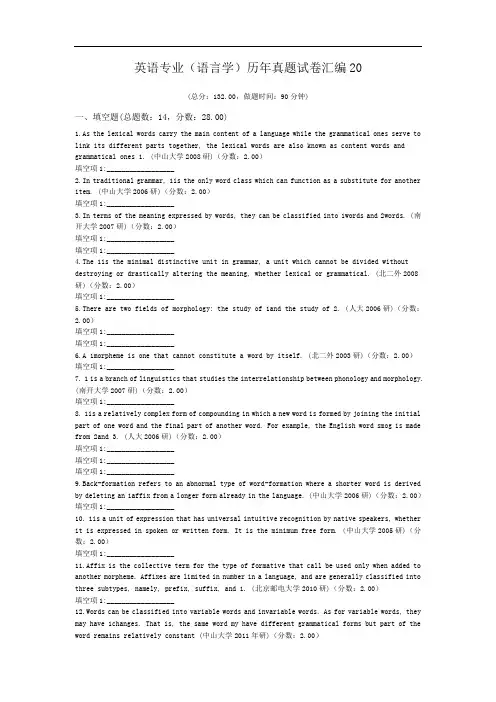
英语专业(语言学)历年真题试卷汇编20(总分:132.00,做题时间:90分钟)一、填空题(总题数:14,分数:28.00)1.As the lexical words carry the main content of a language while the grammatical ones serve to link its different parts together, the lexical words are also known as content words and grammatical ones 1. (中山大学2008研)(分数:2.00)填空项1:__________________2.In traditional grammar, 1is the only word class which can function as a substitute for another item. (中山大学2006研)(分数:2.00)填空项1:__________________3.In terms of the meaning expressed by words, they can be classified into 1words and 2words. (南开大学2007研)(分数:2.00)填空项1:__________________填空项1:__________________4.The 1is the minimal distinctive unit in grammar, a unit which cannot be divided without destroying or drastically altering the meaning, whether lexical or grammatical. (北二外2008研)(分数:2.00)填空项1:__________________5.There are two fields of morphology: the study of 1and the study of 2. (人大2006研)(分数:2.00)填空项1:__________________填空项1:__________________6.A 1morpheme is one that cannot constitute a word by itself. (北二外2003研)(分数:2.00)填空项1:__________________7. 1 is a branch of linguistics that studies the interrelationship between phonology and morphology. (南开大学2007研)(分数:2.00)填空项1:__________________8. 1is a relatively complex form of compounding in which a new word is formed by joining the initial part of one word and the final part of another word. For example, the English word smog is made from 2and 3. (人大2006研)(分数:2.00)填空项1:__________________填空项1:__________________填空项1:__________________9.Back-formation refers to an abnormal type of word-formation where a shorter word is derived by deleting an 1affix from a longer form already in the language. (中山大学2006研)(分数:2.00)填空项1:__________________10. 1is a unit of expression that has universal intuitive recognition by native speakers, whether it is expressed in spoken or written form. It is the minimum free form. (中山大学2005研)(分数:2.00)填空项1:__________________11.Affix is the collective term for the type of formative that call be used only when added to another morpheme. Affixes are limited in number in a language, and are generally classified into three subtypes, namely, prefix, suffix, and 1. (北京邮电大学2010研)(分数:2.00)填空项1:__________________12.Words can be classified into variable words and invariable words. As for variable words, they may have 1changes. That is, the same word my have different grammatical forms but part of the word remains relatively constant (中山大学2011年研)(分数:2.00)填空项1:__________________13.Bound morphemes are classified into two types; 1and 2root.(分数:2.00)填空项1:__________________填空项1:__________________14.A word formed by derivation is called a 1, and a word formed by compounding is called a 2.(分数:2.00)填空项1:__________________填空项1:__________________二、判断题(总题数:12,分数:24.00)15.Some linguists maintain that a word group is an extension of word of a particular class. (清华2001研)(分数:2.00)A.真B.假16.Words are the most stable of all linguistic units in respect of their internal structure. (大连外国语学院2008研)(分数:2.00)A.真B.假17.Nouns, verbs, adjectives and many adverbs are content words. (北二外2008研)(分数:2.00)A.真B.假18.Pronouns, prepositions, conjunctions and articles are all open class items. (清华2001研)(分数:2.00)A.真B.假19.The words "loose" and "books" have a common phoneme and a common morpheme as well. (北二外2007研)(分数:2.00)A.真B.假20.Free morpheme may constitute words by themselves. (大连外国语学院2008研)(分数:2.00)A.真B.假21.Root also falls into two categories: free and bound. (北二外2006研)(分数:2.00)A.真B.假22.A stem is the base form of a word which cannot be further analyzed without total loss of identity. (对外经贸2006研)(分数:2.00)A.真B.假23.The words "water" and "teacher" have a common phoneme and a common morpheme as well. (北二外2006研)(分数:2.00)A.真B.假24.The words "boys" and "raise" have a common phoneme and a common morpheme as well. (北二外2008研)(分数:2.00)A.真B.假25.Analogic change refers to the reduction of the number of exceptional or irregular morphemes. (对外经贸2005研)(分数:2.00)A.真26.The smallest meaningful unit of language is allomorph.(分数:2.00)A.真B.假三、单项选择题(总题数:15,分数:30.00)27.Words like pronouns, prepositions, conjunctions, articles are______items. (北二外2003研)(分数:2.00)A.open-classB.closed-classC.neither open-class nor closed-class28.Nouns, verbs and adjectives can be classified as______. (西安交大2008研)(分数:2.00)A.lexical wordsB.grammatical wordsC.function wordsD.form words29.Bound morphemes do not include______. (西安交大2008研)(分数:2.00)A.rootsB.prefixesC.suffixesD.words30.______other than compounds may be divided into roots and affixes. (大连外国语学院2008研)(分数:2.00)A.Polymorphemic wordsB.Bound morphemesC.Free morphemes31.______refers to the way in which a particular verb changes for tense, person, or number.(西安外国语学院2006研)(分数:2.00)A.AffixationB.InflectionC.DerivationD.Conjugation32.Which two terms can best describe the following pairs of words: table—tables, day + break — daybreak. (大连外国语学院2008研)(分数:2.00)A.inflection and compoundpound and derivationC.inflection and derivationpound words consist of______ morphemes. (北二外2003研)(分数:2.00)A.boundB.freeC.both bound and free34.Which of the following words is formed by the process of blending? (对外经贸2006研)(分数:2.00)A.WTOB.MotelC.BookshelfD.red-faced35.Which of the following words are formed by blending? (对外经贸2005研)(分数:2.00)A.girlfriendB.televisionD.bunch36.The word UN is formed in the way of______. (西安交大2008研)(分数:2.00)A.acronymyB.clippingC.initialismD.blending37.Which of the following is NOT a process of the lexical change? (大连外国语学院2008研)(分数:2.00)A.INVENTION.B.ACRONYM.C.LEXICON.nguage has been changing, but such changes are not so obvious at all linguistic aspects except that of______. (西安外国语学院2006研)(分数:2.00)A.phonologyB.lexiconC.syntaxD.semantics39."Wife", which used to refer to any woman, stands for "a married woman" in modern English. This phenomenon is known as______. (西安交大2008研)(分数:2.00)A.semantic shiftB.semantic broadeningC.semantic elevationD.semantic narrowing40.It is true that words may shift in meaning, i. e. semantic change. The semantic change of the word tail belongs to______.(分数:2.00)A.narrowing of meaningB.meaning shiftC.loss of meaningD.widening of meaning41.A suffix is an affix which appears______.(分数:2.00)A.after the stemB.before the stemC.in the middle of the stemD.below the stem四、简答题(总题数:8,分数:16.00)42.What is the distinction between inflectional affixes and derivational affixes? (四川大学2007研)(分数:2.00)__________________________________________________________________________________________ 43.What does the concept morphophoneme mean? What is the relationship between phoneme and morphophoneme?(南开大学2004研)(分数:2.00)__________________________________________________________________________________________ 44.What are phonologically conditioned and morphologically conditioned form of morphemes? (武汉大学2005研)(分数:2.00)__________________________________________________________________________________________ 45.How are affixes classified? (四川大学2008研)(分数:2.00)__________________________________________________________________________________________46.A number interesting word-formation processes can be discerned in the following examples. Can you identify what is going on in these?(a) The deceased's cremains were scattered over the hill.(b) He's always taking pills, either uppers or downers. (上海交通大学2007研)(分数:2.00)__________________________________________________________________________________________ 47.How to distinguish root and stem?(分数:2.00)__________________________________________________________________________________________ 48.Illustrate the relationship between morpheme and allomorph by examples.(分数:2.00)__________________________________________________________________________________________ 49.What are closed-class words and open-class words?(分数:2.00)__________________________________________________________________________________________五、名词解释(总题数:13,分数:26.00)50.Open-class words (浙江大学2007研)(分数:2.00)__________________________________________________________________________________________ 51.Lexical word (武汉大学2005研)(分数:2.00)__________________________________________________________________________________________ 52.Morpheme (武汉大学2008研)(分数:2.00)__________________________________________________________________________________________ 53.Stem (四川大学2007研)(分数:2.00)__________________________________________________________________________________________ 54.inflectional morpheme (南开大学2004研)(分数:2.00)__________________________________________________________________________________________ 55.Free morphemes (西安交大2008研)(分数:2.00)__________________________________________________________________________________________ 56.Bound morpheme (上海交大2007研)(分数:2.00)__________________________________________________________________________________________ 57.Inflection (四川大学2007研)(分数:2.00)__________________________________________________________________________________________ pound (四川大学2007研)(分数:2.00)__________________________________________________________________________________________ 59.Allomorph (四川大学2006研)(分数:2.00)__________________________________________________________________________________________ 60.Back-formation(四川大学2008研;北外2010研)(分数:2.00)__________________________________________________________________________________________ 61.Prefix (北外2010研)(分数:2.00)__________________________________________________________________________________________ 62.cognate(南开大学2011年研)(分数:2.00)__________________________________________________________________________________________六、1 举例说明题(总题数:4,分数:8.00)63.Illustrate lexical change proper with the latest examples in English, covering at least four aspects. (大连外国语学院2008研)(分数:2.00)__________________________________________________________________________________________ 64.Semantic change plays a very important role in widening the vocabulary of a language. (中山大学2008研)(分数:2.00)__________________________________________________________________________________________ 65.Illustrate the ways of lexical change. (武汉大学2005研)(分数:2.00)__________________________________________________________________________________________ 66.What are the major types of semantic Changes? (人大2006研)(分数:2.00)__________________________________________________________________________________________。
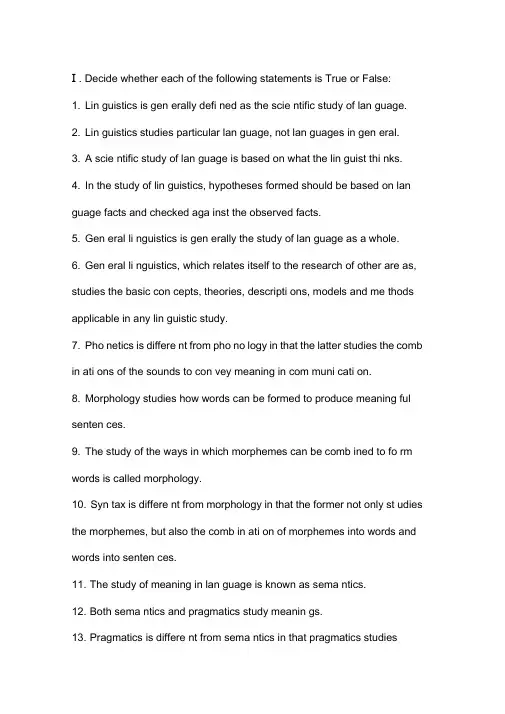
I . Decide whether each of the following statements is True or False:1. Lin guistics is gen erally defi ned as the scie ntific study of lan guage.2. Lin guistics studies particular lan guage, not lan guages in gen eral.3. A scie ntific study of lan guage is based on what the lin guist thi nks.4. In the study of lin guistics, hypotheses formed should be based on lan guage facts and checked aga inst the observed facts.5. Gen eral li nguistics is gen erally the study of lan guage as a whole.6. Gen eral li nguistics, which relates itself to the research of other are as, studies the basic con cepts, theories, descripti ons, models and me thods applicable in any lin guistic study.7. Pho netics is differe nt from pho no logy in that the latter studies the comb in ati ons of the sounds to con vey meaning in com muni cati on.8. Morphology studies how words can be formed to produce meaning ful senten ces.9. The study of the ways in which morphemes can be comb ined to fo rm words is called morphology.10. Syn tax is differe nt from morphology in that the former not only st udies the morphemes, but also the comb in ati on of morphemes into words and words into senten ces.11. The study of meaning in lan guage is known as sema ntics.12. Both sema ntics and pragmatics study meanin gs.13. Pragmatics is differe nt from sema ntics in that pragmatics studiesmeaning not in isolati on, but in con text.14. Social cha nges can ofte n bring about lan guage cha nges.15. Sociolinguistics is the study of language in relation to society.16. Modern linguistics is mostly prescriptive, but sometimes descriptive.17. Moder n lin guistics is differe nt from traditi onal grammar.18. A diachro nic study of lan guage is the descripti on of lan guage at s ome point in time.19. Moder n lin guistics regards the writte n lan guage as primary, not the writte n lan guage.20. The disti ncti on betwee n compete nee and performa nee was propo sed by F. de Saussure.n . Fill in each of the following blanks with one word which begins with the letter give n:21. Chomsky defi nes “ compete nee as the ideal user ' ___________of the rules of his lan guage.22. Lan gue refers to the a ________ lin guistic system shared by allthe members of a speech commu nity while the parole is the con crete use of the conven ti ons and applicati on of the rules.23. D ________ is one of the desig n features of huma n lan guage which refers to the phe nomenon that lan guage con sists of two levels: alower level of mea nin gless in dividual sounds and a higher level of me anin gful un its.24. Lan guage is a system of a ________ v ocal symbols used for human com muni cati on.25. The discipli ne that studies the rules gover ning the formati on of w ords into permissible senten ces in lan guages is called s ______ .26. Huma n capacity for lan guage has a g ____ basis, but the details of lan guage have to be taught and lear ned.27. P ______ refers to the realizati on of lan gue in actual use.28. Findings in lin guistic studies can ofte n be applied to the settlement of some practical problems. The study of such applicati ons is gene rally known as a __________ lin guistics.29. Lan guage is p _________ in that it makes possible the con struction and in terpretati on of new sig nals by its users .In other words, th ey can produce and un dersta nd an infin itely large nu mber of sentenc es which they have n ever heard before.30. Lin guistics is gen erally defi ned as the s _____ study of lan guage.ID . There are four choices following each statement. Mark the choice that can best complete the stateme nt:31. If a lin guistic study describes and an alyzes the lan guage people a ctually use, it is said to be _______ .A. prescriptiveB. an alyticC. descriptiveD. li nguistic32. Which of the follow ing is not a desig n feature of huma n lan guage ?A. Arbitrari nessB. Displaceme ntC. DualityD. Meaningfuln ess33. Moder n lin guistics regards the writte n lan guage as ____ .A. primaryB. correctC. sec on daryD. stable34. In modern linguistics, speech is regarded as more basic than writi ng, because _______ .A. in linguistic evolution, speech is prior to writingB. speech plays a greater role tha n writ ing in terms of the amount ofin formati on con veyedC. speech is always the way in which every n ative speaker acquires h ismother ton gueD. All of the above35. A historical study of Ian guage is a ______ study of Ian guage.A. syn chro nicB. diachro nicC. prescriptiveD. comparative36. Saussure took a(n) ______ view of Ian guage, while Chomsky lo oks at Ian guage from a ______ point of view.A. sociological …psychologicalB. psychological …sociologicalC. applied …pragmaticD. semantic …linguistic37. Accord ing to F. de Saussure, ______ refers to the abstract lingui stic system shared by all the mem- bers of a speech com muni ty.A. paroleB. performa neeC. la ngueD. Language38. Lan guage is said to be arbitrary because there is no logical conne eti on betwee n _____ and meanin gs.A. senseB. soundsC. objectsD. ideas39. Lan guage can be used to refer to con texts removed from the im mediate situati ons of the speaker. This feature is called ______ ,A. displaceme ntB. dualityC. flexibilityD. cultural tran smissi on40. The details of any lan guage system is passed on from one gener ati on to the n ext through _____ , rather tha n by in st in ct.A. learni ngB. teachi ngC. booksD. both A and BIV . Define the following terms:41. Lin guistics42. Phon ology43. Syntax44. Pragmatics45. Psycholi nguistics46. Language47. Pho netics48. Morphology49. Sema ntics50. Socioli nguistics51. Applied Lin guistics52. Arbitrari ness53. Productivity54. Displaceme nt55. Duality56. Desig n Features57. Compete nee58. Performa nee59. Lan gue60. ParoleSuggested an swers to suppleme ntary exercises:I . Decide whether each of the following statements is True or False:I. T 2. F 3. F 4. T 5. T 6. F 7. T 8. F 9. T 10. FII. T 12. T 13. T 14. T 15. T 16. F 17. T 18. F 19. F 20. Fn . Fill in each of the following blanks with one word which begins with the letter give n:21. kno wledge 22. abstract 23. Duality 24. arbitrary 25. syn tax26. genetic 27. Parole 28. applied 29. productive 30. scientific (or sy stematic)ID . There are four choices following each statement. Mark the choice that can best complete the stateme nt.31. C 32. D 33. C 34. D 35. B 36. A 37. C 38. B 39. A 40. DIV . Define the following terms:41. Lin guistics: Lin guistics is gen erally defi ned as the scie ntific study of lan guage.42. Phono logy: The study of how sounds are put together and used i n com muni cati on is called pho no logy.43. Syn tax: The study of how morphemes and words are comb ined t o form senten ces is called syn tax.44. Pragmatics: The study of meaning in con text of use is called prag matics.45. Psycholi nguistics: The study of Ian guage with reference to the wo rkings of mind is called psycholi nguistics.46. Lan guage: Lan guage is a system of arbitrary vocal symbols used for huma n com muni cati on.47. Phonetics: The study of sounds which are used in linguistic comm uni cati on is called phon etics.48. Morphology: The study of the way in which morphemes are arra n ged to form words is called morphology.49. Sema ntics: The study of meaning in lan guage is called sema ntics.50. Socioli nguistics: The study of lan guage with reference to society i s called socioli nguistics.51. Applied lin guistics: In a n arrow sen se, applied lin guistics refers to the applicati on of lin guistic prin ciples and theories to lan guage teach ing and lear ning, especially the teach ing of foreig n and sec ond langu ages. In a broad sen se, it refers to the applicati on of lin guistic finding s to the soluti on of practical problems such as the recovery of speech ability.52. arbitrari ness: It is one of the desig n features of lan guage. It mea ns that there is no logical conn ecti on betwee n meanings and sounds53. Productivity: Language is productive or creative in that it makes possible the con-structi on and in terpretati on of new sig nals by its users.54. Displaceme nt: Displaceme nt means that lan guage can be used to refer to thi ngs which are prese nt or not prese nt, real or imag ined m atters in the past, prese nt, or future, or in far-away places. In other words, la nguage can be used to refer to con texts removed from the i mmediate situati ons of the speaker55. Duality: The duality n ature of lan guage means that lan guage is a system, which con sists of two sets of structure, or two levels, one of sounds and the other of meanin gs.56. Design features: Design features refer to the defining properties of huma n lan guage that dist in guish it from any ani mal system of com muni cati on57. Compete nee: Chomsky defi nes compete nee as the ideal user 'n owledge of the rules of his lan guage,58. Performanee: performanee is the actual realization of the knowledge of the rules in lin guistic com muni cati on.59. la ngue: Lan gue refers to the abstract lin guistic system shared by all the members of a speech com muni ty; Lan gue is the set of conven tions and rules which lan guage users all have to follow; Lan gue is relatively stable, it does not cha nge freque ntly60. Parole: Parole refers to the realizati on of lan gue in actual use; pa role is the con crete use of the conven ti ons and the applicati on of the rules; parole varies from pers on to pers on, and from situati on to situ atio n.。
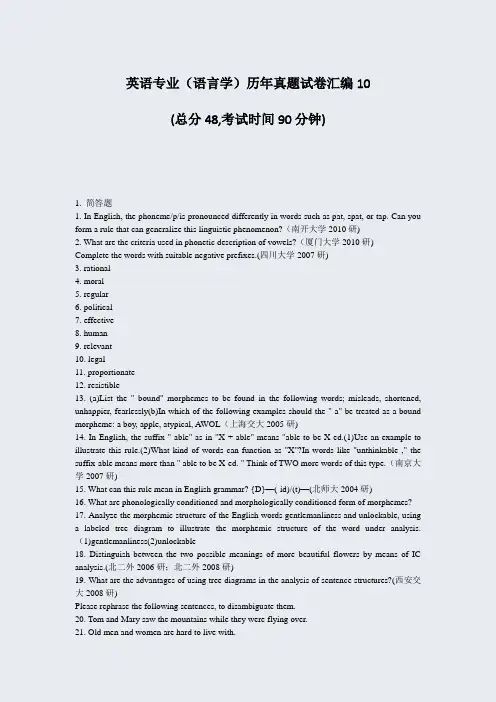
英语专业(语言学)历年真题试卷汇编10(总分48,考试时间90分钟)1. 简答题1. In English, the phoneme/p/is pronounced differently in words such as pat, spat, or tap. Can you form a rule that can generalize this linguistic phenomenon?(南开大学2010研)2. What are the criteria used in phonetic description of vowels?(厦门大学2010研)Complete the words with suitable negative prefixes.(四川大学2007研)3. rational4. moral5. regular6. political7. effective8. human9. relevant10. legal11. proportionate12. resistible13. (a)List the " bound" morphemes to be found in the following words; misleads, shortened, unhappier, fearlessly(b)In which of the following examples should the " a" be treated as a bound morpheme: a boy, apple, atypical, AWOL(上海交大2005研)14. In English, the suffix "-able" as in "X + able" means "able to be X-ed.(1)Use an example to illustrate this rule.(2)What kind of words can function as "X"?In words like "unthinkable ," the suffix-able means more than " able to be X-ed. " Think of TWO more words of this type.(南京大学2007研)15. What can this rule mean in English grammar? {D}—(-id)/(t)—(北师大2004研)16. What are phonologically conditioned and morphologically conditioned form of morphemes?17. Analyze the morphemic structure of the English words gentlemanliness and unlockable, usinga labeled tree diagram to illustrate the morphemic structure of the word under analysis.(1)gentlemanliness(2)unlockable18. Distinguish between the two possible meanings of more beautiful flowers by means of IC analysis.(北二外2006研;北二外2008研)19. What are the advantages of using tree diagrams in the analysis of sentence structures?(西安交大2008研)Please rephrase the following sentences, to disambiguate them.20. Tom and Mary saw the mountains while they were flying over.21. Old men and women are hard to live with.22. They said she would go yesterday.23. The governor is a dirty street fighter.24. We deplore the shooting of the hunters.。
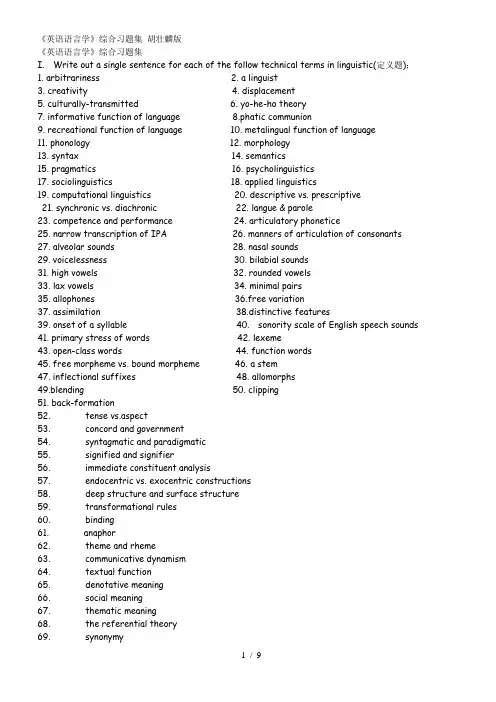
《英语语言学》综合习题集胡壮麟版《英语语言学》综合习题集I. Write out a single sentence for each of the follow technical terms in linguistic(定义题);1. arbitrariness2. a linguist3. creativity4. displacement5. culturally-transmitted6. yo-he-ho theory7. informative function of language 8.phatic communion9. recreational function of language 10. metalingual function of language11. phonology 12. morphology13. syntax 14. semantics15. pragmatics 16. psycholinguistics17. sociolinguistics 18. applied linguistics19. computational linguistics 20. descriptive vs. prescriptive21. synchronic vs. diachronic 22. langue & parole23. competence and performance 24. articulatory phonetice25. narrow transcription of IPA 26. manners of articulation of consonants 27. alveolar sounds 28. nasal sounds29. voicelessness 30. bilabial sounds31. high vowels 32. rounded vowels33. lax vowels 34. minimal pairs35. allophones 36.free variation37. assimilation 38.distinctive features39. onset of a syllable 40. sonority scale of English speech sounds 41. primary stress of words 42. lexeme43. open-class words 44. function words45. free morpheme vs. bound morpheme 46. a stem47. inflectional suffixes 48. allomorphs49.blending 50. clipping51. back-formation52. tense vs.aspect53. concord and government54. syntagmatic and paradigmatic55. signified and signifier56. immediate constituent analysis57. endocentric vs. exocentric constructions58. deep structure and surface structure59. transformational rules60. binding61. anaphor62. theme and rheme63. communicative dynamism64. textual function65. denotative meaning66. social meaning67. thematic meaning68. the referential theory69. synonymy70. gradable antonymy71. hyponymy72. superordinate73. semantic components74. propositional logic75. syllogism76. psychology of language77. recency effect78. semantic association network79. garden path sentences80. minimal attachment theoryII. Short-answer Questions (简答题):Directions: Explain each of the following linguistic views in no more than 50 words. .1. What is Displacement of language?2. How to understand that language is productive?3. How to understand language is dually-structured?4. Why lingu ists say “All the languages are equal”?5. Comment on the saying “Language is culturally-transmitted”。
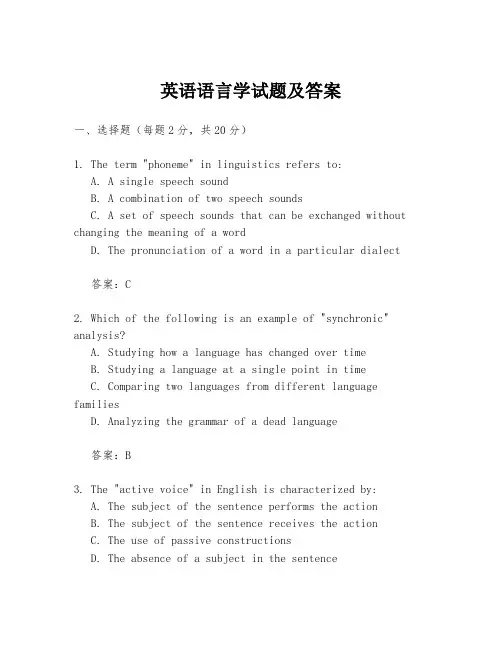
英语语言学试题及答案一、选择题(每题2分,共20分)1. The term "phoneme" in linguistics refers to:A. A single speech soundB. A combination of two speech soundsC. A set of speech sounds that can be exchanged without changing the meaning of a wordD. The pronunciation of a word in a particular dialect答案:C2. Which of the following is an example of "synchronic" analysis?A. Studying how a language has changed over timeB. Studying a language at a single point in timeC. Comparing two languages from different language familiesD. Analyzing the grammar of a dead language答案:B3. The "active voice" in English is characterized by:A. The subject of the sentence performs the actionB. The subject of the sentence receives the actionC. The use of passive constructionsD. The absence of a subject in the sentence答案:A4. Which of the following sentence structures is considered "inverse"?A. Subject-Verb-ObjectB. Object-Subject-VerbC. Verb-Object-SubjectD. Subject-Object-Verb答案:B5. The process of "creolization" results in the formation of:A. A pidginB. A dialectC. A creoleD. A standard language答案:C6. In English, the word "run" can function as:a. A nounb. A verbc. An adjectived. All of the above答案:D7. The term "register" refers to:A. The highest pitch a voice can reachB. A dialect used by a particular social groupC. The level of formality in language useD. A type of linguistic accent答案:C8. The "universal grammar" hypothesis was proposed by:A. Noam ChomskyB. B.F. SkinnerC. Ferdinand de SaussureD. Edward Sapir答案:A9. The "allophone" of the English phoneme /p/ in the word "spin" is:A. Aspirated [pʰ]B. Unaspirated [p]C. Voiced [b]D. Voiceless [p]答案:A10. The linguistic concept of "polysemy" refers to:A. The use of a single word to express multiple meaningsB. The use of multiple words to express a single meaningC. The change in meaning of a word over timeD. The complete replacement of one word by another答案:A二、填空题(每题2分,共20分)1. The study of language in relation to the brain and the nervous system is known as __________.答案:neurolinguistics2. A(n) __________ is a word that has a meaning and stands alone, typically consisting of a single morpheme.3. The __________ of a word is the set of words that are used together with it and influence its meaning.4. In linguistics, __________ refers to the smallest unit of meaning in a language.5. The __________ is the standard form of a verb that is typically used when conjugating the verb in the present tense.6. A(n) __________ is a word that is formed from a root word and one or more affixes.7. The __________ is the study of the historical developmentof languages.8. The __________ is the systematic study of the structureand function of words.9. The __________ is the study of the way in which languages change over time due to contact with other languages.10. The __________ is the branch of linguistics that studies the sounds of a language and how they function in a system ofcommunication.三、简答题(每题10分,共30分)1. 描述语音学中的“最小对立对”概念,并给出一个英语例子。
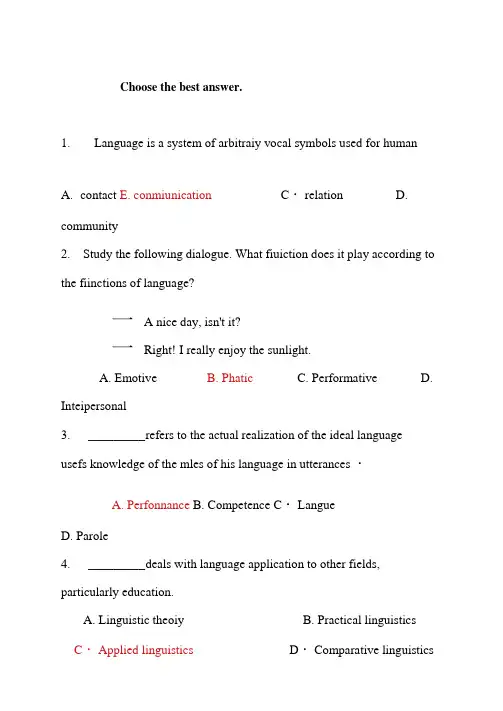
Choose the best answer.nguage is a system of arbitraiy vocal symbols used for humanA.contact E. conmiunication C・ relation D. community2.Study the following dialogue. What fiuiction does it play according to the fiinctions of language?一 A nice day, isn't it?一Right! I really enjoy the sunlight.A. EmotiveB. PhaticC. PerformativeD. Inteipersonal3._________ r efers to the actual realization of the ideal language usefs knowledge of the mles of his language in utterances ・A. PerfonnanceB. Competence C・ LangueD. Parole4._________ d eals with language application to other fields, particularly education.A. Linguistic theoiyB. Practical linguisticsC・ Applied linguistics D・ Comparative linguistics5._________ answers such questions as how we as infantsacquire our first language.A. PsycholinguisticsB.Anthropological linguisticsD. Applied linguisticsC. Sociolinguistics6.Pitch variation is known as __________ w hen its patterns are imposed on sentences・A. intonation E. tone C. pronunciationD. voice -7.Conventionally a __________ i s put iii slashes (/ /)・A. allophoneB. phoneC. phonemeD. moipheme8.Ail aspiiated p, an unaspirated p and an um'eleased p are of the p phoneme.A. analoguesB. tagmemes C・ moiphemesD. 一allophones9.Tlie opening between the vocal cords is sometimes refeiTed to asA. glottis B・ vocal cavity C. phaiynxuvula10.The diphthongs that are made with a movement of the tonguetowards the center are known as _________ diphthongs.A.wideB. closing C・ lianow D. centering11 ・ A phoneme is a gioup of similar soiuids called _________ ・A. minimal pairs E・ allomoiphs C・ phonesD.allophones12.Which branch of phonetics concerns the production of speechsounds?B.Aiticulatoiy phoneticsA. Acoustic phoneticsC・ Auditoiy phonetics D・ None of the above 13.Which one is different from the others according to places of articulation?A. [n]B. [m]C. [ b ]D. [p]14.AVliich vowel is different from the others according to the characteristics of vowels?A. [i:]B. [ ii ]C. [e]D.[i]15.What kind of sounds can we make when the vocal cords are vibrating?A.VbicelessB. VoicedC. Glottal stopD.------------------Consonant16.Nouns, verbs and adjectives can be classified asA.1 exical wordsB. gianmiatical wordsC・ fimction words D. form words17.Moiphemes that represent tense, number, gender and case arecalled _________ morpheme.A. inflectional E. free C. bound D. derivational18.There are __________ moiphemes in the word denationalization ・A. tlneeB. fourC. fiveD. six19.In English 一ise and 一tion are called ____ ・A. prefixes E. suffixes C・ infixesD. stemsTlie three subtypes of affixes are: prefix, suffix and _________ ・20.A. derivational affix E. inflectional affix C・ infixD.back-fbmiation21._________is a way in which new words may be fbnned fromalready existing words by subtracting ail affix which is thought to be part of the old word.A. affixationB. back-fomiation C・ insertion D.addition22.The word TB is fbnned in the way of __________ ・A. acronymyB. clippingC. initialismD.——blending23.The words like comsat and sitcom are fbnned byA. blendingB. clippingC. back-formationD.acronymy24.The stem of disagieements is _________ ・A. agieement E・ agree C. disagiee D. disagieement25.All of them are meaningfiil except for _________ ・A. lexemeB. phonemeC. moiphemeD. allomoiph26.The sentence stmcture is _______ ・A. only linearB. only hierarchicalplexD. both linear and hierarchical27・ The syntactic mles of any language are _____ in number.D.infinite C・ finite E・ small A. large28. The ___________ mles are the mles that group words and pliiases to fbnn gianuiiatical sentences・A. lexical B・ moiphological C・ linguistic D・combinational29・ A sentence is considered ______ w hen it does not confonn to the grammatical knowledge in the mind of native speakers・A. rightB. wrongC. grammaticalD.ungrammatical30. A _________ ill the embedded clause refers to the introductoiy word that introduces the embedded clause.A. coordinatorB. particleC. prepositionD. subordinator31.Pliiase stmctiire mles have ___ properties・A. recursiveB. gianmiatical C・ social D・fiinctional -32.Pliiase structure rules allow us to better understandA・ how words and pluases fbmi sentences.B.what constitutes the grammaticality of strings of wordsC・ how people produce and recognize possible sentencesD. all of the above・33 ・ The head of the phrase “ the city Rome M is _____________ ・A. the cityB. RomeC. cityD. the city RomeThe phrase “ on the shelf” belongs to ____________ constmction・34.A. endocentricB. exocentiicC. subordinate D・coordinate35・ The sentence “ They were wanted to remain quiet and not to exposethemselves. ” is a ___________ s entence.A. simple E. coordinate C. compoundD.complex 36.The naming theoiy is advanced by _______ ・ A. Plato B. BloomfieldC. Geoffrey LeechD. Filth — 37.“ Can I bonow your bike? ” _______ “ You have a bike. ” A. is synonymous with E ・ is inconsistentwithC. entailsD.presupposes 38._________ is a way in which the meaning of a word can bedissected into meaning components, called semantic features.40 ・ ________ d eals with the relationship between the linguisticelement and the non-linguistic world of experience.A. Predication analysis C ・ Phonemic analysis 39.“Alive” and “dead”A. gradable antonyms relational antonymsC. complementaiy antonyms the above B. Componential analysisD. Grammatical analysis are______________ .B.D. None ofD. Sense41 ・ __________ r efers to the phenomenon that words having different meanings have the same form. A. Polysemy E. Synonymy C ・ Homonymy D.Hyponymy42・ Words that are close in meaning are called ______________ ・A. homonyms E. polysemies C. hyponymsD. synonyms43 ・ What essentially distinguishes semantics and pragmatics is whether in the study of meaning _______________ is considered.A. referenceB. speech actC. practical usageD. context44. A sentence is a ____________ concept, and the meaning of a sentence一is often studied ill isolation.A. pragmatic B ・ grammaticalC. mentalconceptual45 ・ If we think of a sentence as what people actually utter in the courseA. ReferenceB ・ Concept C. SemanticsD.of communication, it becomes a (n) _________ ・A. constative E. directive C. utterance D. expressive46・ Speech act theoiy did not come into being until ____________ ・A.in the late 50's of the 20the centiuy B・ in the early 1950's -C.in the late 1960'sD. in the early 21stcentiuy47._________ i s the act perfbnned by or resulting from saying something; it is the consequence of, or the change brought about by the utterance ・E.Ail illocutionaiy actA. A locutionaiy actC.A perlocutionaiy actD. A perfomiative act48.____ is a branch of gianunar which studies the intemal stmctiire of words and the rnles by which words are formed.49. A. Syntax B. Grammar C. MoiphologyD.Moipheme50.____ a re often thouglit to be the smallest meaningfiil units of language by the linguists.A. WordsB. MoiphemesC. PhonemesD. Sentences51."-s” in the word “books” is ____________ .52.A. a derivative affix E・ a stem C・ an inflectional affix D. a root53.Boiuid moiphemes are classified into two types: __ affix ____ a nd __bound root _______ .54.The theoiy of __________ condition explains the fact that noun pluases appear only in subject and object positions.55.__________ refers to the phenomenon that words having different meanings have the same fbmi.A. Polysemy E. Synonymy C. Homonymy D. HyponymyThe gianunaticality of a sentence is governed by ______ ・ 56.A. granunatical lilies B・ selectional restrictionsC・ semantic mles D. semantic features57. Wliat essentially distinguishes semantics and pragmatics is whether in the study of meaning ________ is considered.A. referenceB. speech actC. practical usageD・ context58・ A sentence is a ________ concept, and the meaning of a sentence isoften studied ill isolation.A. pragmatic B・ grammatical C. mental D. conceptual59.If we think of a sentence as what people actually utter in the course of communication, it becomes a (n) ____________ ・A. constative E・ directive C・ utterance D. expressive60.Which of the following is tme?A.Utterances usually do not take the fbnn of sentences・B.Some utterances camiot be restored to complete sentences・C.No utterances can take the fonn of sentences・D.All utterances can be restored to complete sentences・65 ・ Speech act theoiy did not come into being until ___________ ・A. in the late 50's of the 20the centiuy B・ in the early 1950'sC. ill the late 1960*sD. in the early 21stcentiuy66・________ is the act perfomied by or resulting from saying something; it is the consequence of, or the change brought about by the utterance.A. A locutionaiy act E・Ailillocutionaiy actC. A perlocutionaiy act D・ A perfbnnative act67. According to Searle, the illocutionaiy point of the representative isA. to get the hearer to do somethingB・ to commit the speaker to something's being the caseC・ to commit the speaker to some fiitiire course of actionD.to express the feelings or attitude towards an existing state of affairs68. All the acts that belong to the same categoiy share the same purpose, but they differ _________ .A. in their illocutionaiy acts E. in their intentions expressedC. in theii' strength or force D・ ill their effect brouglit about69・ _________ is advanced by Paul GriceA. Cooperative PrincipleB. Politeness PrincipleC・ Tlie General Principle of Universal Grammar D. Adjacency Principle70.Wlien any of the maxims under the cooperative piiiiciple is flouted, ______ might arise.B.contradictionsA. impolitenessC.mutual imderstandingD. conversational implicatiires71.The person who is often described as “ father of modern linguistics v isA. FirthB. Saussure C・ HallidayD.Chomsky72.Tlie most important contribution of the Prague School to linguistics is that it sees language in teniis of __________ ・A. fiinctionB. meaningC. signsD. system73.Tlie principal representative of American descriptive linguistics isA. BoasB. SapirC. BloomfieldD. Hanis74.Generally speaking, the _________ specifies whether a certain tagmeme is in the position of the Nucleus or of the Margin in the stmcture.A. SlotB. ClassC. RoleD. Cohesion75・________ Grammar is the most widespread and the best understood method of discussing Indo-European languages・A. TraditionalB. StmcturalC. Functional D・Generative76.________ Grammar started from the American linguist SydneyM.Lamb in the late 1950s and the early 1960s・A. StratificationalB. CaseC. RelationalD.Montague77.In Hallida/s view, the __________ f imction is the fiuiction that thechild uses to know about his sunoundiiigs.A. personalB. heuristicC. imaginativeD.infbnnative7& Tlie rheme in the sentence “ On it stood Jane M is ______________ ・A. On itB. stoodC. On it stoodD. Jane79.Chomsky follows __________ in philosophy and mentalism inpsychology.A. empiricismB. behaviorismC. relationalismD.mentalism80.TG grammar has seen __________ s tages of development.A. threeB. fourC. fiveD. sixII.Explain the following terms, using examples・1.linguisticspetenceCompetence: It is an essential part of performance. It is the speakers knowledge of his or her language; that is, of its sound stnictoe, its words, and its gianmiatical niles. Competence is, in a way, ail encyclopedia of language・ Moreover, the knowledge involved in competence is generally unconscious. A transfbnnational-generative grammar is a model of competence.3 ・ Syiicliionic linguisticsSynchronic linguistics: It refers to the study of a language at a given point in time. The time studied may be either the present or a particular point in the past; syiichroiiic analyses can also be made of dead languages, such as Latin. Synchronic linguistics is contrasted with diachronic linguistics, the study of a language over a period of time.4.Sound assimilationSound assimilation: Speech sounds seldom occur ill isolation. In comiected speech, under the influence of their neighbors, are replaced by other sounds. Sometimes two neighboring soiuids influence each other and are replaced by a third sound which is different from both original sounds. This process is called sound assimilation.5.AllomoiphAllomoiph: It is any of the variant fbnns of a moipheme as conditioned by position or adjoining sounds・6.phonology7.SyntaxSyntax: Syntax refers to the mles governing the way words are combined to fbmi sentences in a language, or simply, the study of the fbmiation of sentences.8.referential theoiy9.PerfbnnativePerfbnnative: In speech act theoiy an utterance which perfbnns an act, such as Watch out (= a warning).10.Locutionaiy actLocutionaiy act: A locutionaiy act is the saying of something which is meaningfiil and can be understood.11.phoneticsplementaiy distributionComplementaiy distribution: The different allophones of the same phoneme never occur in the same phonetic context. When tw。
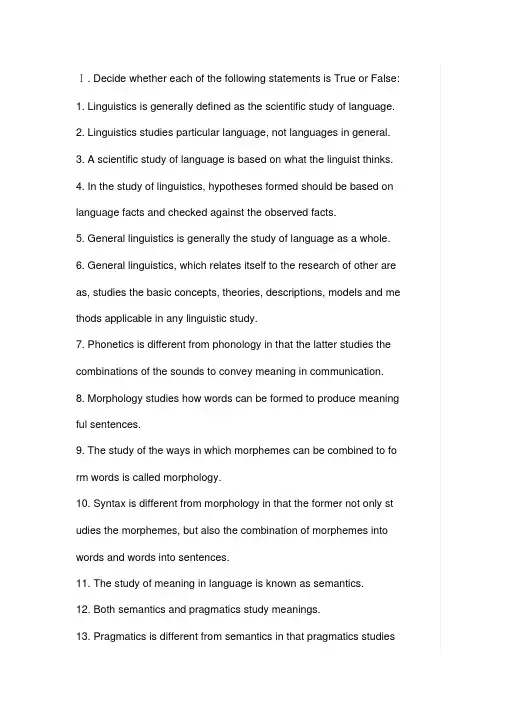
Ⅰ. Decide whether each of the following statements is True or False:1. Linguistics is generally defined as the scientific study of language.2. Linguistics studies particular language, not languages in general.3. A scientific study of language is based on what the linguist thinks.4. In the study of linguistics, hypotheses formed should be based on language facts and checked against the observed facts.5. General linguistics is generally the study of language as a whole.6. General linguistics, which relates itself to the research of other are as, studies the basic concepts, theories, descriptions, models and me thods applicable in any linguistic study.7. Phonetics is different from phonology in that the latter studies the combinations of the sounds to convey meaning in communication. 8. Morphology studies how words can be formed to produce meaning ful sentences.9. The study of the ways in which morphemes can be combined to fo rm words is called morphology.10. Syntax is different from morphology in that the former not only st udies the morphemes, but also the combination of morphemes into words and words into sentences.11. The study of meaning in language is known as semantics.12. Both semantics and pragmatics study meanings.13. Pragmatics is different from semantics in that pragmatics studiesmeaning not in isolation, but in context.14. Social changes can often bring about language changes.15. Sociolinguistics is the study of language in relation to society.16. Modern linguistics is mostly prescriptive, but sometimes descripti ve.17. Modern linguistics is different from traditional grammar.18. A diachronic study of language is the description of language at s ome point in time.19. Modern linguistics regards the written language as primary, not the written language.20. The distinction between competence and performance was propo sed by F. de Saussure.Ⅱ. Fill in each of the following blanks with one word which begins with the letter given:k__________ 21. Chomsky defines “competence”as the ideal user’sof the rules of his language.22. Langue refers to the a__________ linguistic system shared by allthe members of a speech community while the parole is the concrete use of the conventions and application of the rules.23. D_________ is one of the design features of human language which refers to the phenomenon that language consists of two levels: alower level of meaningless individual sounds and a higher level of me aningful units.24. Language is a system of a_________ vocal symbols used for hu man communication.25. The discipline that studies the rules governing the formation of w ords into permissible sentences in languages is called s________.26. Human capacity for language has a g_______ basis, but the deta ils of language have to be taught and learned.27. P _______ refers to the realization of langue in actual use.28. Findings in linguistic studies can often be applied to the settleme nt of some practical problems. The study of such applications is gene rally known as a________ linguistics.29. Language is p___________ in that it makes possible the construc tion and interpretation of new signals by its users. In other words, th ey can produce and understand an infinitely large number of sentenc es which they have never heard before.30. Linguistics is generally defined as the s _______ study of languag e.Ⅲ. There are four choices following each statement. Mark the choice that can best complete the statement:31. If a linguistic study describes and analyzes the language people actually use, it is said to be _______.A. prescriptiveB. analyticC. descriptiveD. linguistic32. Which of the following is not a design feature of human language ?A. ArbitrarinessB. DisplacementC. DualityD. Meaningfulness33. Modern linguistics regards the written language as _______.A. primaryB. correctC. secondaryD. stable34. In modern linguistics, speech is regarded as more basic than writi ng, because _______.A. in linguistic evolution, speech is prior to writingB. speech plays a greater role than writing in terms of the amount of information conveyedC. speech is always the way in which every native speaker acquires h is mother tongueD. All of the above35. A historical study of language is a _______ study of language.A. synchronicB. diachronicC. prescriptiveD. comparative36. Saussure took a(n) _______ view of language, while Chomsky lo oks at language from a ________ point of view.A. sociological…psychologicalB. psychological…sociologicalC. applied…pragmaticD.semantic…linguistic37. According to F. de Saussure, _______ refers to the abstract lingui stic system shared by all the mem- bers of a speech community.A. paroleB. performanceC. langueD. Language38. Language is said to be arbitrary because there is no logical conne ction between _______ and meanings.A. senseB. soundsC. objectsD. ideas39. Language can be used to refer to contexts removed from the im mediate situations of the speaker. This feature is called _______,A. displacementB. dualityC. flexibilityD. cultural transmission40. The details of any language system is passed on from one gener ation to the next through _______, rather than by instinct.A. learningB. teachingC. booksD. both A and BⅣ. Define the following terms:41. Linguistics42. Phonology43. Syntax44. Pragmatics45. Psycholinguistics46. Language47. Phonetics48. Morphology49. Semantics50. Sociolinguistics51. Applied Linguistics52. Arbitrariness53. Productivity54. Displacement55. Duality56. Design Features57. Competence58. Performance59. Langue60. ParoleSuggested answers to supplementary exercises:Ⅰ. Decide whether each of the following statements is True or False:1. T2. F3. F4. T5. T6. F7. T8. F9. T 10. F11. T 12. T 13. T 14. T 15. T 16. F 17. T 18. F 19. F 20. FⅡ. Fill in each of the following blanks with one word which begins wi th the letter given:21. knowledge 22. abstract 23. Duality 24. arbitrary 25. syntax 26. genetic 27. Parole 28. applied 29. productive 30. scientific (or sy stematic)Ⅲ. There are four choices following each statement. Mark the choice that can best complete the statement.31. C 32. D 33. C 34. D 35. B 36. A 37. C 38. B 39. A 40. DⅣ. Define the following terms:41. Linguistics: Linguistics is generally defined as the scientific study of language.42. Phonology: The study of how sounds are put together and used i n communication is called phonology.43. Syntax: The study of how morphemes and words are combined to form sentences is called syntax.44. Pragmatics: The study of meaning in context of use is called prag matics.45. Psycholinguistics: The study of language with reference to the wo rkings of mind is called psycholinguistics.46. Language: Language is a system of arbitrary vocal symbols used for human communication.47. Phonetics: The study of sounds which are used in linguistic comm unication is called phonetics.48. Morphology: The study of the way in which morphemes are arran ged to form words is called morphology.49. Semantics: The study of meaning in language is called semantics.50. Sociolinguistics: The study of language with reference to society i s called sociolinguistics.51. Applied linguistics: In a narrow sense, applied linguistics refers to the application of linguistic principles and theories to language teach ing and learning, especially the teaching of foreign and second langu ages. In a broad sense, it refers to the application of linguistic finding s to the solution of practical problems such as the recovery of speech ability.52. arbitrariness: It is one of the design features of language. It means that there is no logical connection between meanings and sounds53. Productivity: Language is productive or creative in that it makes possible the con-struction and interpretation of new signals by its users.54. Displacement: Displacement means that language can be used torefer to things which are present or not present, real or imagined matters in the past, present, or future, or in far-away places. In other words, language can be used to refer to contexts removed from the i mmediate situations of the speaker55. Duality: The duality nature of language means that language is a system, which consists of two sets of structure, or two levels, one of sounds and the other of meanings.56. Design features: Design features refer to the defining propertiesof human language that distinguish it from any animal system of com municationkn 57. Competence: Chomsky defines competence as the ideal user’sowledge of the rules of his language,58. Performance: performance is the actual realization of the knowledge of the rules in linguistic communication.59. langue: Langue refers to the abstract linguistic system shared byall the members of a speech community; Langue is the set of conventions and rules which language users all have to follow; Langue is relatively stable, it does not change frequently60. Parole: Parole refers to the realization of langue in actual use; pa role is the concrete use of the conventions and the application of the rules; parole varies from person to person, and from situation to situ ation.。
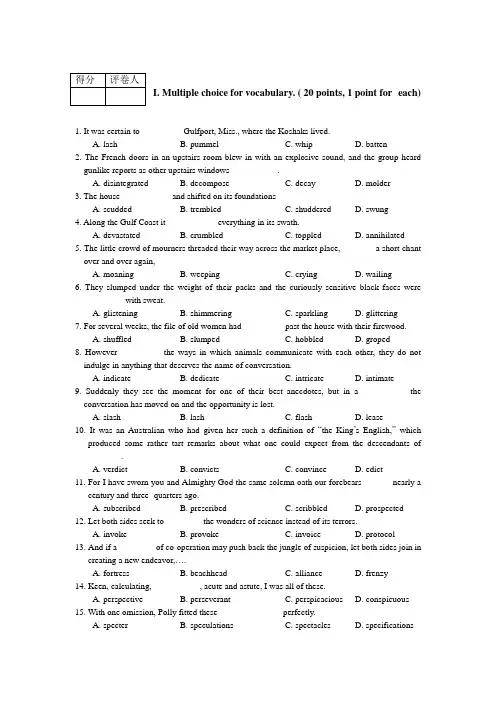
I. Multiple choice for vocabulary. ( 20 points, 1 point for each)1. It was certain to _________ Gulfport, Miss., where the Koshaks lived.A. lashB. pummelC. whipD. batten2. The French doors in an upstairs room blew in with an explosive sound, and the group heard gunlike reports as other upstairs windows __________ .A. disintegratedB. decomposeC. decayD. molder3. The house ___________ and shifted on its foundationsA. scuddedB. trembledC. shudderedD. swung4. Along the Gulf Coast it ___________ everything in its swath.A. devastatedB. crumbledC. toppledD. annihilated5. The little crowd of mourners threaded their way across the market place, _______ a short chant over and over again,A. moaningB. weepingC. cryingD. wailing6. They slumped under the weight of their packs and the curiously sensitive black faces were _________ with sweat.A. glisteningB. shimmeringC. sparklingD. glittering7. For several weeks, the file of old women had _________ past the house with their firewood.A. shuffledB. slumpedC. hobbledD. groped8. However _________ the ways in which animals communicate with each other, they do not indulge in anything that deserves the name of conversation.A. indicateB. dedicateC. intricateD. intimate9. Suddenly they see the moment for one of their best anecdotes, but in a __________ the conversation has moved on and the opportunity is lost.A. slashB. lashC. flashD. lease10. It was an Australian who had given her such a definition of “the King’s English,”whichproduced some rather tart remarks about what one could expect from the descendants of _______ .A. verdictB. convictsC. convinceD. edict11. For I have sworn you and Almighty God the same solemn oath our forebears ______ nearly acentury and three- quarters ago.A. subscribedB. prescribedC. scribbledD. prospected12. Let both sides seek to ________ the wonders of science instead of its terrors.A. invokeB. provokeC. invoiceD. protocol13. And if a ________ of co-operation may push back the jungle of suspicion, let both sides join increating a new endeavor,….A. fortressB. beachheadC. allianceD. frenzy14. Keen, calculating, __________ , acute and astute, I was all of these.A. perspectiveB. perseverantC. perspicaciousD. conspicuous15. With one omission, Polly fitted these ______________ perfectly.A. specterB. speculationsC. spectaclesD. specifications16. She had an erectness of carriage, an ease of bearing, a _______ that clearly indicated the bestof breeding.A. poseB. poiseC. postureD. pore17. As the __________ of science, technology also exhibits the universalizing tendency.A. consequenceB. corollaryC. coronationD. corpulent18. But somehow I had never quite sensed its appalling ___________ .A. barrenB. abominationC. desolationD. agony19. I award this championship only after laborious research and _________ prayer.A. incessantB. consistentC. constantD. endless20. No wonder that this puts a _________ on slovenly work, on slowdowns, and on other tricks toget the same pay check with less work.A. premiumB. premierC. premiereD. premonitionII. Point out the figures of speech used in each sentence andwrite your answer on the Answer Sheet. (20points, 2 points foreach figure of speech)1.The hurricane, in one mighty swipe, lifted the entire roof off the house and skimmed it 40 feet through the air.2. .This wretched boy, who is a French citizen and has therefore been dragged fromthe forest to scrub floors and catch syphilis, actually has feelings of reverencebefore a white skin.3.Bar friends are like the musketeers of Dumas who did not delve into each other'slives.4.Let both sides explore what problems unite us instead of belaboring thoseproblems which divide us.5. We observe today not a victory of party but a celebration of freedom, symbolizingan end as well as a beginning, signifying renewal as well as change.6.To our sister republics south of our border, we offer a special pledge: to convertour good words into good deeds.......7.She was, to be sure, a girl who excited the emotions , but I was not one to let myheart rule my head.8.Intelligent she was not. In fact, she veered in the opposite direction.9.The country itself is not uncomely, despite the grime of the endless mills. It isincredible that mere ignorance should have achieved such masterpiece ofhorror.。
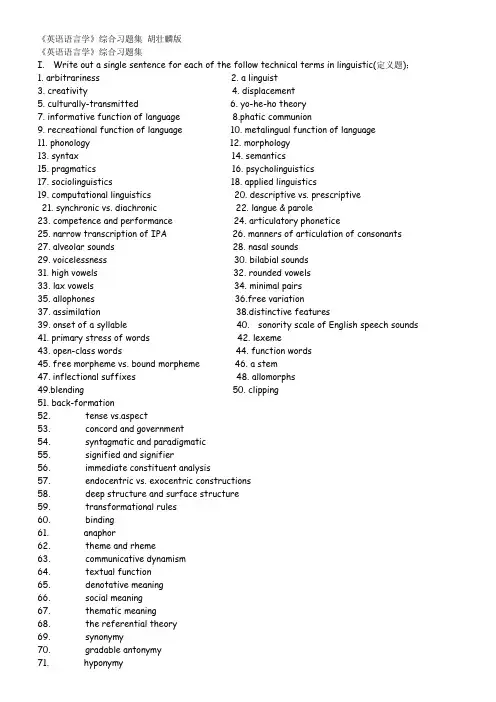
《英语语言学》综合习题集胡壮麟版《英语语言学》综合习题集I. Write out a single sentence for each of the follow technical terms in linguistic(定义题);1. arbitrariness2. a linguist3. creativity4. displacement5. culturally-transmitted6. yo-he-ho theory7. informative function of language 8.phatic communion9. recreational function of language 10. metalingual function of language11. phonology 12. morphology13. syntax 14. semantics15. pragmatics 16. psycholinguistics17. sociolinguistics 18. applied linguistics19. computational linguistics 20. descriptive vs. prescriptive21. synchronic vs. diachronic 22. langue & parole23. competence and performance 24. articulatory phonetice25. narrow transcription of IPA 26. manners of articulation of consonants 27. alveolar sounds 28. nasal sounds29. voicelessness 30. bilabial sounds31. high vowels 32. rounded vowels33. lax vowels 34. minimal pairs35. allophones 36.free variation37. assimilation 38.distinctive features39. onset of a syllable 40. sonority scale of English speech sounds 41. primary stress of words 42. lexeme43. open-class words 44. function words45. free morpheme vs. bound morpheme 46. a stem47. inflectional suffixes 48. allomorphs49.blending 50. clipping51. back-formation52. tense vs.aspect53. concord and government54. syntagmatic and paradigmatic55. signified and signifier56. immediate constituent analysis57. endocentric vs. exocentric constructions58. deep structure and surface structure59. transformational rules60. binding61. anaphor62. theme and rheme63. communicative dynamism64. textual function65. denotative meaning66. social meaning67. thematic meaning68. the referential theory69. synonymy70. gradable antonymy71. hyponymy72. superordinate73. semantic components74. propositional logic75. syllogism76. psychology of language77. recency effect78. semantic association network79. garden path sentences80. minimal attachment theoryII. Short-answer Questions (简答题):Directions: Explain each of the following linguistic views in no more than 50 words. .1. What is Displacement of language?2. How to understand that language is productive?3. How to understand language is dually-structured?4. Why lingu ists say “All the languages are equal”?5. Comment on the saying “Language is culturally-transmitted”。
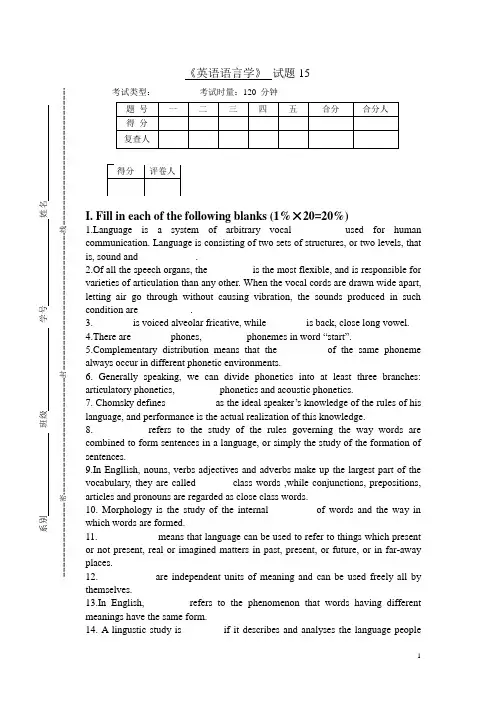
《英语语言学》 试题15考试类型: 考试时量:120 分钟I. Fill in each of the following blanks (1%×20=20%) nguage is a system of arbitrary vocal _________used for human communication. Language is consisting of two sets of structures, or two levels, that is, sound and ___________. 2.Of all the speech organs, the ________ is the most flexible, and is responsible for varieties of articulation than any other. When the vocal cords are drawn wide apart, letting air go through without causing vibration, the sounds produced in such condition are __________. 3. _______ is voiced alveolar fricative, while _______ is back, close long vowel. 4.There are _______ phones, ________ phonemes in word “start ”. plementary distribution means that the ________ of the same phoneme always occur in different phonetic environments. 6. Generally speaking, we can divide phonetics into at least three branches: articulatory phonetics, ________ phonetics and acoustic phonetics. 7. Chomsky defines _________ as the ideal speaker ’s knowledge of the rules of his language, and performance is the actual realization of this knowledge. 8.__________ refers to the study of the rules governing the way words are combined to form sentences in a language, or simply the study of the formation of sentences. 9.In Engllish, nouns, verbs adjectives and adverbs make up the largest part of the vocabulary, they are called ______ class words ,while conjunctions, prepositions, articles and pronouns are regarded as close class words. 10. Morphology is the study of the internal ________ of words and the way in which words are formed. 11. ___________ means that language can be used to refer to things which present or not present, real or imagined matters in past, present, or future, or in far-away places. 12. __________ are independent units of meaning and can be used freely all bythemselves.13.In English, _______ refers to the phenomenon that words having different meanings have the same form.14. A lingustic study is _______ if it describes and analyses the language people系别 班级 学号 姓名 ------------------------------密-----------------------------------------------封-------------------------------------------------------线-------------------------------------------------------actually use; it is prescriptive if it tries to lay down rules for “correct ” behavior.15.Suprasegmental features include ________ tone and intonation.16. “Accuse …of ” and “charge …with ” are _______ synonyms.II .Read and decide the best one that completes the statement. (1.5%×20=30%)1. Linguists give priority to the spoken language not on the written language because_________.A. vocal sounds are drived from writing systemsB. speech precedes writing everywhere in the worldC. we have reading devices to study speechD. spoken language preceded writtten language only in Indo-European languae2. According to F. de Saussure, _______ refers to the abstract linguistics.A. paroleB. performanceC. langueD. language3. ________ is concerned with all the sounds that occur in the world ’s language.A. PhonologyB. PhoneticsC. MorphologyD. Phonemics.4. The word “boyish ” contains two ______.A. morphemesB. morphsC. phonemesD. allophones5. Noun, verb, _____ and preposition are major lexical cateogries.A. adverbB. pronounC. adjectiveD. conjunction6. Which of the following sounds is voiceless bilabial stop?A. [p]B. [m]C. [b]D. [t]7. The study of language to psychology is __________.A. sociolinguisticsB. psycholinguisticsC. applied linguisticsD. pragmatics8. Which of the following sounds is central vowel?A. [ e ]B. [i]C. []D. [a:]9. In English, “un-” and “dis ” are called _________..A. prefixesB. infixesC. suffixesD. grammatical words10. ______ are produced by moving from one vowel position to another through interventing position.A. DiphthongsB. ConsonantsC. V owelsD. Individual vowels11.The phrase “ men and women ” belongs to the _________ contruction.A. predicateB. coordinateC. subordinateD. exocentric12.In English, all the front vowels and the central vowels are _______ vowels.A. unroundedB. closeC. openD. rounded13.Which is the meaning relationship between the two words “flower/rose ”?A. HomonymyB. AntonymyC. PolysemyD. Hyponymy14. The words such as “lab ”, “doc ” are ________.A. formed by blendingB. acronymsC. coined by back-formationD. clipped words15. In English if three consonants should cluster together at the beginning of a word, the first phoneme must be /s/ and the second phoneme must be /p/ or /t/ or /k/, then the third phoneme can not be _______.A. /f/B. /l/C. /r/D. /w/16. The words “make” and “bus” are called ________ because they can occurunattached.A.derivational morphemesB. inflectional morphemesC.bound morphemesD. free morphemes17.The semantic component of the word “man”can be expressed as________.A. +animate, +human, +male, -adultB. +animate, +human, -male, +adultC. +animate, +human, +male, +adultD. +animate, +human, -male, -adult18. ______ refers to the linguistic variety characteristic of a particular socialclass.A. IdiolectB. SociolectC. Ethnic dialectD. Standard dialect19. The phenomenon “holiday meant a day of religious significance before,but today it signifies any day on which we don’t have to work” is _______A. widening of the meaningB. narrowing of meaningC. meaning shiftD.loss of the meaning20. All of the following are American English EXCEPT ______.A. fallB. elevatorC. petrolD. aparmentIII. True or false: ( T for True and F for Array False).(1.5%×20=30%)nguage is human specific.2. English is a typical tone language.3. A synchronic study of language is a historical study.4. The classification of English consonants involves both manner of articultion and place of articulation.5. The distinction between competence and performance was proposed by F. de Saussure.6. Speech and writing came into being at much the same time in the human history.7. The word “ungentlemanliness” has five morphemes.8. Deep Structure is the same as Surface Structure.9. There is only one type of affixes in the English language.10. Syntax is the branch of linguistics which studies the meaning of language.11. A locutionary act is the act of conveying literal meaning by means of syntax, lexicon, and phonology.12.Modern English is roughly from 499 to the present.13. The standard language and non-standard language are both socially prestigious.14. The assumption that Black English is “genetically inferior ”, “deficient ” and “incomplete ” is quite unreasonable.15. One of the recent trends of language change is moving towards greater formality.16. Pragmatics is related to and also different from semantics.17.In a pair of gradable antonyms, the denial of one member of the pair implies the assertion of the other.18. There is only one argument in the sentence “ Kids like apples.”19. Free morphemes are the same as bound morphemes.20. IPA stands for International Phonetic Alphabet.IV . Draw tree structures of the following sentences. (2.5%×4=10%)1. The apple might hit the man.2. Jim has washed the dirty shirts and pants.3. The children argued over whether bats had wings.4. What are you doing now?V .Please answer the following questions. (5%×2=10%)1.Please list out the design features of language and illustrate them.2. Who put forward the Cooperative Principle? What is it about?Answer SheetI.Fill in each of the following blanks (1%×20=20%) 1.__________,__________2.__________,__________3.__________,___________ 4._________,_________5.___________6.__________,7.__________8._________, 9.___________10._____________11._____________12.____________ 13.____________.14.____________15.___________16._____________ II .Read and decide the best one that completes the statement. (1.5%×20=30%) 1( ) 2( ) 3( ) 4( ) 5( ) 6( ) 7( ) 8( ) 9( ) 10( ) 11( ) 12( ) 13( ) 14( ) 15( ) 16( ) 17( ) 18( ) 19( ) 20( ) III. True or false: ( T for True and F for False). (1.5%×20=30%) 1.( ) 2( ) 3( ) 4( ) 5( ) 6( ) 7( ) 8( ) 9( ) 10( ) 11( ) 12( ) 13( ) 14( ) 15( ) 16( ) 1(7 ) 18( ) 19( ) 20( ) IV . Draw tree structures of the following sentences. (2.5%×4=10%) 1. The apple might hit the man. 2. Jim has washed the dirty shirts and pants.系别班级学号姓名 ------------------- ---------------------密-------------------------------------------封-------------------------------------线----------------------------------------------3. The children argued over whether bats had wings.4. What are you doing now?V.Please answer the following questions. Array (5%×2=10%)1.____________________________________________________________________________ _____________________________________________________________________________ _____________________________________________________________________________ _____________________________________________________________________________ _____________________________________________________________________________ _____________________________________________________________________________ _____________________________________________________________________________ _____________________________________________________________________________ ____________________________________________________________________________ _____________________________________________________________________________2.____________________________________________________________________________ _____________________________________________________________________________ _____________________________________________________________________________ _____________________________________________________________________________ _____________________________________________________________________________ _____________________________________________________________________________ _____________________________________________________________________________ _____________________________________________________________________________ _____________________________________________________________________________ _____________________________________________________________________________ _________________________________________________________________________________________________________________________________________________________。
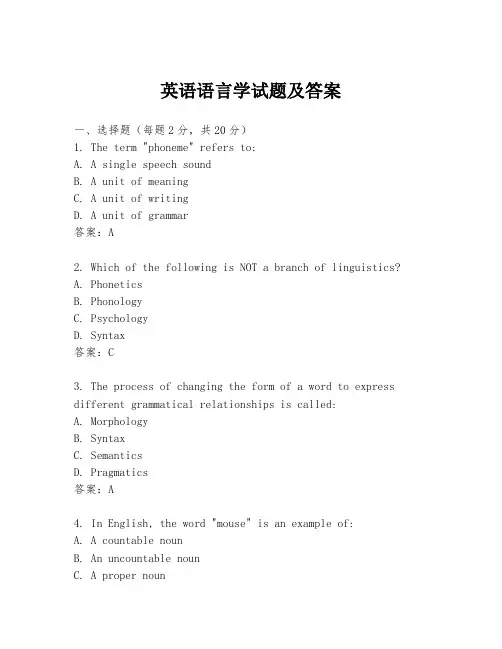
英语语言学试题及答案一、选择题(每题2分,共20分)1. The term "phoneme" refers to:A. A single speech soundB. A unit of meaningC. A unit of writingD. A unit of grammar答案:A2. Which of the following is NOT a branch of linguistics?A. PhoneticsB. PhonologyC. PsychologyD. Syntax答案:C3. The process of changing the form of a word to express different grammatical relationships is called:A. MorphologyB. SyntaxC. SemanticsD. Pragmatics答案:A4. In English, the word "mouse" is an example of:A. A countable nounB. An uncountable nounC. A proper nounD. An article答案:A5. The study of meaning in language is known as:A. SemanticsB. PragmaticsC. SyntaxD. Phonology答案:A6. The smallest unit of sound that can distinguish meaning ina language is called:A. PhonemeB. MorphemeC. SyllableD. Word答案:A7. The branch of linguistics that studies the social aspects of language is:A. SociolinguisticsB. PsycholinguisticsC. NeurolinguisticsD. Computational linguistics答案:A8. The use of language in context is studied in:A. SemanticsB. PragmaticsC. SyntaxD. Phonology答案:B9. The process of acquiring a first language is known as:A. Second language acquisitionB. Foreign language learningC. Language learningD. First language acquisition答案:D10. The systematic arrangement of words and phrases to create well-formed sentences is the study of:A. PhonologyB. SyntaxC. SemanticsD. Pragmatics答案:B二、填空题(每题2分,共20分)1. The study of speech sounds is called ____________.答案:Phonetics2. The smallest meaningful unit of language is known as a____________.答案:Morpheme3. The branch of linguistics that deals with the structure of words is ____________.答案:Morphology4. The study of how language is used in social contexts is called ____________.答案:Sociolinguistics5. The process by which children acquire their first language is known as ____________.答案:Language acquisition6. The study of the rules governing the formation of sentences in a language is ____________.答案:Syntax7. The branch of linguistics that examines the psychological aspects of language is ____________.答案:Psycholinguistics8. The study of the meanings of words, phrases, and sentences is known as ____________.答案:Semantics9. The branch of linguistics concerned with the relationship between language and culture is ____________.答案:Anthropological linguistics10. The study of how language is processed in the brain is called ____________.答案:Neurolinguistics三、简答题(每题10分,共30分)1. Explain the difference between a phoneme and an allophone. 答案:A phoneme is the smallest unit of sound that can distinguish meaning in a language, while an allophone is a variant of a phoneme that does not change the meaning of aword.2. What is the role of syntax in language?答案:Syntax is the set of rules, principles, and processes that govern the structure of sentences in a language,including how words and phrases are arranged to create well-formed sentences.3. How does sociolinguistics contribute to our understandingof language?答案:Sociolinguistics helps us understand how languagevaries according to social factors such as class, gender, age, and ethnicity, and how these variations affect communication and social interaction.四、论述题(每题15分,共30分)1. Discuss the importance of pragmatics in language communication.答案:Pragmatics is crucial in language communication as it deals with the way context influences the interpretation of meaning. It helps us understand how speakers convey intended meanings beyond the literal interpretation of words and sentences, taking into account factors such as tone, body language, and shared knowledge.2. Explain the concept of language universals and give examples.答案:Language universals refer to the structural and functional features that are common to all human languages. Examples include the presence of nouns and verbs, the use ofword order to convey meaning, and the ability to form questions and negations.。
1 第一部分 选择题 I. Directions: Read each of the following statements carefully. Decide which one of the four choices best completes the statement and put the letter A, B, C or D in the brackets. (2%×10=20%) 1、As modern linguistics aims to describe and analyze the language people actually use, and not to lay down rules for "correct" linguistic behavior, it is said to be ___. A、 prescriptive B、 sociolinguistic C、 descriptive D、 psycholinguistic 2、Of all the speech organs, the ___ is/are the most flexible. A、 mouth B、 lips C、 tongue D、 vocal cords 3、The morpheme "vision" in the common word "television" is a(n) ___. A、 bound morpheme B、 bound form C、 inflectional morpheme D、 free morpheme 4、A ___ in the embedded clause refers to the introductory word that introduces the embedded clause. A、 coordinator B、 particle C、 preposition D、 subordinator主从连词 5、"Can I borrow your bike?" ___ "You have a bike." A、 is synonymous with B、 is inconsistent with C、 entails D、 presupposes 6、The branch of linguistics that studies how context influences the way speakers interpret sentences is called ___. A、 semantics B、 pragmatics C、 sociolinguistics D、 psycholinguistics 7、Grammatical changes may be explained, in part, as analogic changes, which are ___ or generalization泛化. A、 elaboration B、 simplification精简 C、 external borrowing D、 internal borrowing 8、___ refers to a marginal language of few lexical items and straightforward grammatical rules, used as a medium of communication. A、 Lingua franca通用语 B、 Creole C、 Pidgin D、 Standard language标准语言 9、Psychologists, neurologists and linguists have concluded that, in addition to the motor area which is responsible for physical articulation of utterances, three areas of the left brain are vital to language, namely, ___ . A、 Broca's area, Wernicke's area and the angular gyrus角回 B、 Broca's area, Wernicke's area and cerebral cortex C、 Broca's area, Wernicke's area and neurons D、 Broca's area, Wernicke's area and Exner's area 10、According to Krashen, ___ refers to the gradual and subconcious development of ability in the first language by using it naturally in daily communicative situations. A、 learning B、 competence 2
C、 performance D、 acquisition 第二部分 非选择题 II. Directions: Fill in the blank in each of the following statements with one word, the first letter of which is already given as a clue. Note that you are to fill in One word only, and you are not allowed to change the letter given. (1%×10=10%) 11、Chomsky defines "competence" as the ideal user's k of the rules of his language. 12、The four sounds /p/,/b/,/m/ and /w/have one feature in common, i.e, they are all b . 13、M is a branch of grammar which studies the internal structure of words and the rules by which words are formed. 14、A s is a structurally independent unit that usually comprises a number of words to form a completestatement, question or command. 15、Synonyms that are mutually substitutable under allcircumstances are called c synonyms. 16、The illocutionary point of r is to commit the speaker to something's being the case, to the truth of what has been said. 17、Words are created outright to fit some purpose. Such a method of enlarging the vocabulary is known as word c . 18、Wherever the standard language can use a contraction (he+is→he's), Black English can d the form of "be". 19、The basic essentials of the first language are acquired in the short period from about age two to puberty, which is called the c period for first language acquisition. 20、As a type of linguistic system in 12 learning, i is a product of L2 training, mother tongue intereference, overgeneralization of the target language rules, and learning and communicative strategies of the learner. III. Directions: Judge whether each of the following statements is true or false. Put a T for true or F for false in the brackets in front of each statement. If you think a statement is false, you must explain why you think so and give the correct version. (2%×10=20%) ()21、In modern linguistic studies, the written form of language is given more emphasis than the spoken form for a number of reasons. ()22、Voicing is a phonological feature that distinguishes meaning in both Chinese and English. ()23、The compound word "bookstore" is the place where books are sold. This indicates that the meaning of a compound is the sum total of the meanings of its components. ()24、Syntactic categories refer to sentences (S) and clauses (C) only. ()25、Dialectal synonyms can often be found in different regional dialects such as British English and American English but cannot be found within the variety itself, for example, within British English or American English. ()26、Only when a maxim under Cooperative Principle is blatantly violated and the hearer knows that it is being violated do conversational implicatures arise. ()27、The territory in which the Indo-European languages are mainly spoken today also includes languages that are not Indo-European. ()28、In most bilingual communities, two languages have the same in speech situations known as domains. ()29、According to the strong version of the Sapir-Whorf hypothesis, speakers' perceptions determine language and pattern their way of life. ()30、All normal children have equal ability to acquire their first language. IV. Directions: Explain the following terms, using one or two examples for illustration. (3%×10=30%) 31、duality 32、diachronic linguistics 33、broad transcription 34、morphological rules 35、phrase structure rule 36、relational opposites 37、componential analysis 38、context 39、euphemism 40、brain lateralization